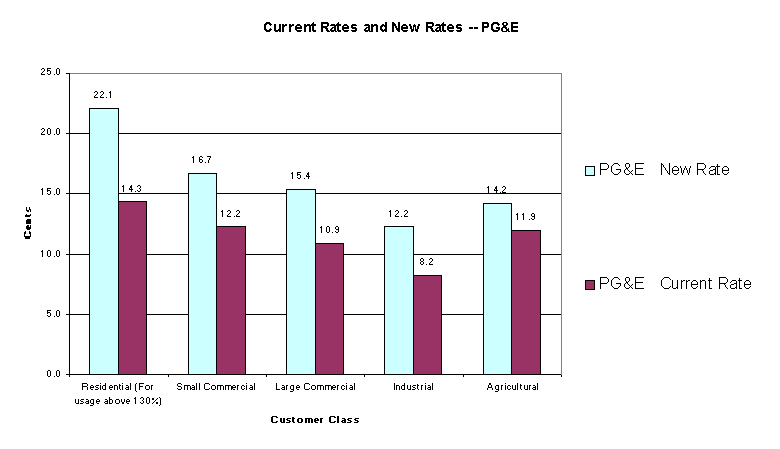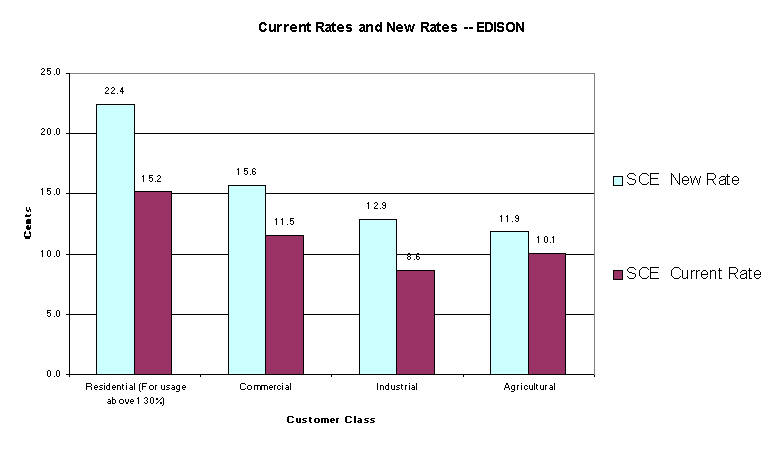COM/LYN/abw * DRAFT Item 1a
5/14/2001
Decision ALTERNATE PROPOSED DECISION OF COMMISSIONER LYNCH
BEFORE THE PUBLIC UTILITIES COMMISSION OF THE STATE OF CALIFORNIA
|
Application of Southern California Edison Company (E 3338-E) for Authority to Institute a Rate Stabilization Plan with a Rate Increase and End of Rate Freeze Tariffs. |
Application 00-11-038 (Filed November 16, 2000) |
|
Emergency Application of Pacific Gas and Electric Company to Adopt a Rate Stabilization Plan. (U 39 E) |
Application 00-11-056 (Filed November 22, 2000) |
|
Petition of THE UTILITY REFORM NETWORK for Modification of Resolution E-3527. |
Application 00-10-028 (Filed October 17, 2000) |
(See Appendix A for List of Appearances.)
INTERIM OPINION REGARDING RATE DESIGN
I. Summary
This decision responds to the energy crisis that has burdened California's consumers and economy for the past twelve months by:
· Adopting rates for various types of customers;
· Applying a rate design to existing electric energy revenue needs for the purchase and supply of electricity by the California Department of Water Resources (CDWR), Pacific Gas and Electric Company (PG&E) and Southern California Edison Company (Edison); and
· Expediting the allocation among customers of the three-cent-per-kilowatt-hour average rate increase adopted on March 27, 2001.
These new rates must be implemented as soon as practicable to provide sufficient revenues for power and to maximize conservation this summer.
California consumers are facing an unbounded, unjust, unreasonable and unlawful wholesale price regime for a fundamental economic necessity which has no substitute -electricity. We continue to look to the federal government to moderate wholesale prices. The Federal Energy Regulatory Commission (FERC) has refused to perform its legal duty to assure just and reasonable wholesale energy rates. Its failure to restrain wholesale electricity price gouging is directly responsible for the hardship that will be suffered by the families, farms and businesses of California as a result of higher electricity prices. In the face of federal indifference, we are working within the framework established by the Governor and the Legislature to sustain, as best we can, the energy economy of California.
Every consumer in California is justified in feeling outrage at the rates we approve today and the bills they will have to pay tomorrow. We share the sense of outrage.
The rate schedules we approve today will severely affect the electricity bills of every Californian, excepting only the poorest and most vulnerable customers. In moving forward today with revenue allocation and rate design, we do not in any manner concede that the wholesale electricity costs which are the basis for these rates are just or reasonable, or in any way lawful under the Federal Power Act, 16 USC section 824 et seq.
Today's decision allocates the three-cent-per-kilowatt-hour (kWh) average rate increase authorized to be charged to the customers of CDWR, Edison and PG&E in Decision D. 01-03-082. We recognize that PG&E and Edison are not now purchasing all their customers' electricity and that some electricity is being sold directly to customers by DWR. We adopted the three-cent per kWh surcharge on March 27, 2001 in order to enable the utilities to comply with their statutory obligation to serve, and to enable CDWR to provide and pay for enough wholesale electricity to serve customers as provided by AB1X.
The estimated revenue increase from this 3¢/kWh surcharge totals approximately $2.5 billion annually to be paid by the customers of each utility. In this decision, we also allocate the recovery of the authorized 3¢ per/kWh rate surcharge from March 27, 2001, the time of authorization, to June 1, 2001, the beginning of surcharge recovery. The amount of additional revenue raised through this period totals $903 million ($420 million from Edison customers and $423 million from PG&E customers) which we amortize in customer bills over the next twelve-month period.
In this decision we fundamentally change how residential customers will pay for the electricity they use. We adopt five residential rate tiers which correlate to the amount of electricity used per month and allocate the rate surcharge to be paid by the three highest usage tiers as follows:
Tier 1: up to 100% of baseline No increase by statute
Tier 2: 100-130% of baseline No increase by statute
Tier 3: 130-200% of baseline 12% increase or less, depending on usage
Tier 4: 200-300% of baseline 29% increase or less, depending on usage
Tier 5: over 300% of baseline 47% increase or less, depending on usage
As mandated by AB 1x, all residential usage below 130% of baseline is exempted from further rate surcharges. However, for every residential customer who uses more than 130% of baseline, (which is adjusted by climate zone) each additional kilowatt-hour used will be charged at an increasingly higher rate. Thus, those residences who use more than 300% of their baseline usage will pay much more than those who use less than 200% of baseline. As AB 1x removed over 60% of all residential use from the possibility of further rate increases, the remaining non-exempt residential use will bear the costs of higher electric use.
In addition, we exempt all customers who qualify for the California Alternative Rates for Energy (CARE) program from paying the surcharge, as we stated in our March 27, 2001 order,1 and we also exempt from paying the surcharge all usage of customers on medical baseline rates Finally, in response to the Governor's proposal to recognize the unique role agriculture plays in California's and the nation's economy, we cap agricultural rate increases at a range of 15-20 percent, depending on the agricultural customer tariff.
After accounting for these four adjustments - permitting recovery of the rate increases effective March 27th, exempting residential usage below 130% of baseline as required by statute, exempting CARE-eligible and medical baseline customers from rate increases and capping rate increases for agricultural customers - the rate increases we implement in today's order average 4.51 cents per kWh for non-exempt customers. Customers may experience higher or lower bill increases depending on their usage. Through the device of a bill limiter, we will attempt to assist customers who experience the most extreme bill increases.
The charts below details the new average electricity rates by customer type. These charts demonstrate that even with the new rates, large commercial and industrial customers will still pay less per kilowatt of electricity used than residential customers and small commercial businesses.


If the rates were set at the actual cost of energy consumed, the increases allocated among customers today would be substantially higher. These average rates reflect the fact that the real cost of electricity provided by DWR will be financed through the issuance of long-term bonds that will be repaid over time by ratepayers. Unless and until the FERC decides to enforce the law, even these astronomical new average rates may prove inadequate to cover exorbitant wholesale electricity prices in the California market.
Our rate design decision today promotes several objectives. We intend to pursue a fundamentally fair allocation of the costs of the energy consumed by customers of the utilities and CDWR. While rejecting the assigned commissioner's proposal to tier commercial rates and retaining the original commercial rate structures in effect prior to the increases, we will apply the new increases in a manner that moves the energy cost component of customer's bills closer to equality, recognizing that the wholesale energy consumed by each customer is fungible and is priced in a manner that bears no relation to its cost under the current FERC regime.
Under the conditions we face in California today, equitably allocating rate increases among California businesses, farms, and families involves inevitable burdens. For a quarter century California has been committed to the principle that electric energy is a necessity of modern life and that a basic quantity of energy usage should remain affordable.2 Statutory mandates direct the Commission that in establishing all electricity and gas rates, the Commission must "observ[e] the principle that electricity and gas services are necessities, for which a low affordable rate is desirable." Section 739(c)(2).3 At the same time, California has been committed to assuring that business energy costs enable companies to remain competitive in the worldwide marketplace. C.f., Sections 743, 743.1 and 744.4 The unconscionable and unlawful wholesale prices Californians currently face make achieving either of these goals extraordinarily difficult. We have called upon our institutional expertise and experience as well as our understanding of law and policy to make hard choices based on the law, California energy policy and the record before us. These choices will please no one, least of all ourselves.
In addition to the goal of equity, we intend to promote conservation in order to reduce energy demand and energy usage. Wholesale price gouging is occurring at all hours, and under all load conditions. Reducing total consumption at all hours is necessary. Reducing energy consumption at peak hours may also enhance system reliability when California is projected to face the severest shortages.
Many parties argue that rates should be designed to fall primarily on those who consume electricity during peak summer hours, between noon and 6 p.m. All projections indicate and all experts agree that California may generally face electricity supply shortages during summer peak periods. However, as California has experienced since December, our supply and wholesale market pricing challenges are not limited to summer peak periods. Allocating the rate increases only to summer peak fails to promote conservation in all hours and disproportionately disadvantages those families, farms and businesses that cannot shift electricity use away from the summer peak period.
Another goal of the rates we adopt today is to provide customers and this Commission with information and technical tools to respond to the wholesale costs and conditions we will face this summer. Hence we are proposing a real time pricing pilot program and are encouraging large commercial customers to use energy meters to better control electrical use at times of greatest price or demand. We also propose a separate market rate pilot program for federal facilities that comports with federal policy in support of customers' paying the market costs of wholesale power.5
The rates adopted in this order become effective June 1, 2001. We intend to fine-tune these rate charges and categories through additional proceedings by July. Specifically, we seek additional information and analysis of certain rate design options discussed herein. Through the next eight weeks, we also intend to monitor the effects of certain rate design and allocation methods adopted today.
1 We also increased the eligibility criteria for the electric customers participating in the CARE program from 150% to 175% of the federal poverty guideline. Additional CARE eligibility and outreach issues are being addressed in proceedings now underway at the Commission, A.00-11-009 et al. 2 Chapter 1010, Stats. 1975, Miller-Warren Energy Lifeline Act, Sec. 1(a) provides: "Light and heat are basic human rights and must be made available to all the people at low cost for basic minimum quantities." Cf., Stats. 1982, ch. 1541, section 1(d), continuing this program in effect. 3 All statutory references are to the Pub. Util. Code, unless otherwise noted. 4 Stats. 1985, ch. 1392, Section 1 is a representative legislative declaration: "It is the intent of the legislature that the Public Utilities Commission take cognizance of the competitive disadvantages endured by many industrial users of large quantities of electricity in this state,...that the commission ...adopt...rate structures for these users...so as to improve this competitive situation and enhance the business environment of California...." 5 Representative public policy positions of the federal government are summarized in Attachment A. We take official notice of these public statements and policy positions of federal officials pursuant to Rule 73 of the Commission's Rules of Practice and Procedure.

